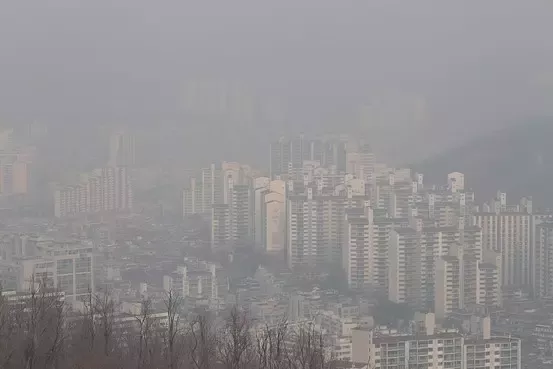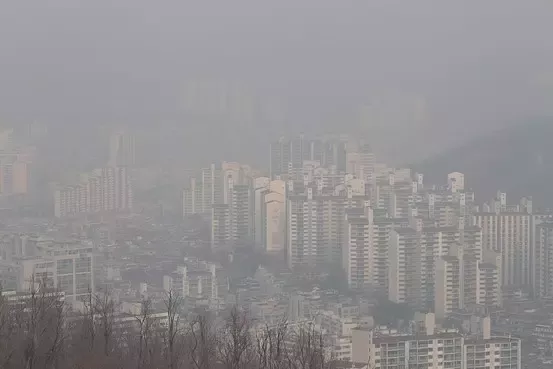Physical Address
304 North Cardinal St.
Dorchester Center, MA 02124
Physical Address
304 North Cardinal St.
Dorchester Center, MA 02124

The Statistics Research Institute of South Korea has been polling the populace about the state of the air they breathe for more than ten years. Since 2012, the result has mostly remained the same: low levels of satisfaction corroborate South Korea’s issue.
Historical data reveals that air quality in South Korea has faced challenges since the late 20th century, largely attributable to rapid industrial expansion.
From the 1990s onwards, the level of pollutants such as PM10 and nitrogen dioxide significantly increased, which prompted governmental action including stricter emissions regulations and investment in renewable energy sources.
This historical context highlights the persistent nature of air quality issues as the nation seeks to balance economic growth with environmental protection.
Due to its rapid industrialisation, Seoul’s capital has notably poor air quality. Seoul is among the cities in the world with the worst air pollution, according to NASA. The mean PM10 levels in Seoul were higher between 2009 and 2013 than in several of the world’s largest cities, including Los Angeles, Tokyo, Paris, and London. Additionally, it is estimated that in the Seoul metropolitan region in 2010, air quality contributed to about 16% of all fatalities.
AIR QUALITY IN SEOUL: A NATIONAL PROBLEM

The average air quality in South Korea in 2019 was “moderate,” according to IQAir, a Swiss business that develops air quality technology and has an air quality platform that provides real-time data on the world’s air quality. However, the amount of PM2.5 (atmospheric particulate matter with a diameter of less than 2.5 micrometres) was twice as high as what was advised. The nation was ranked 26th overall that year out of 98 countries.
Concentrations of air pollutants decreased by 27% in Korea in 2020, as was the case nearly elsewhere due to the disruption of operations brought on by the Covid-19 pandemic. The pandemic’s disruption should not, however, conceal a fact that is known as fine dust or yellow dust in Korea.
The worst air quality in the nation is found in Seoul, the capital city, which is home to almost 10 million people. In fact, if current levels of the city’s excessive pollution persist, average citizens will live 1.7 years less.
In 2024, the Seoul Metro system launched a ₩300 billion investment programme aimed at reducing dust pollution across its network.
With approximately 7 million daily passengers, the initiative includes improved ventilation, air conditioning upgrades, and the installation of dust-trap mats.
The goal is to lower the average pollution concentration from 38.8 μg/m3 to 32 μg/m3 by 2026, well within the legal limit of 50 μg/m3.
WHAT CAUSES THE POOR AIR QUALITY
Korea witnessed the greatest yellow dust storm of the previous ten years in March 2021. This phenomenon, which first appears in the deserts of China and Mongolia, especially in the Spring, transports with it dangerous particles such as sulphur, carbon monoxide, heavy metals, and other carcinogenic material along with viruses, bacteria, fungi, pesticides, antibiotics, herbicides, and plastic components that hasten and exacerbate lung and cardiovascular diseases as well as different types of cancer.
Local health authorities classify PM10 (solid or liquid dust, ash, soot, meal, or pollen) values between 0 and 30 micrograms as excellent, between 31 and 80 micrograms as normal, and between 81 and 150 micrograms as poor. In March of last year, they reached 545 micrograms in Seoul, and the authorities advised susceptible groups to stay indoors.
Yellow dust storms have always existed, but due to increased deforestation in Central Asia, they have become more frequent, especially when there is little precipitation and anticyclones release warm or stagnant air into the atmosphere. Many in Korea attribute the rise in dangerous particles contained in these dust storms to China’s industrial activities, which is now considerably more intense than in the past.
Comparing South Korea’s air quality initiatives with those of its neighbours reveals varied approaches.
Japan has long invested in technology-driven solutions like advanced filtration systems, while China has implemented aggressive policies to reduce coal consumption.
South Korea’s collaborative efforts with China, including satellite monitoring, reflect a regional commitment to tackling transboundary pollution challenges collectively.
Measures to improve air quality include using drones, robots, satellites, and artificial rain.
The Korean government is trying to improve the quality of the air by putting various initiatives into place now that they are aware of the issue:
Robots with 5-G connectivity and air quality monitors started patrolling the Jeonju industrial complex in South Korea last year. The data gathered will then be used for the city’s environmental control because it is more effective and can access more places than the inspectors patrolling the factories.
A new partnership between the United Nations Environment Program and the Seoul, Incheon, and Gyeonggi Province Capital Metropolitan Area of the Republic of Korea will assist officials in stepping up their efforts to combat air pollution and in sharing their best practises with other areas that experience poor air quality.
The surveillance firm Hancom inSpace has been chosen to create an automatic drone system to observe coastal pollution for more than 20 minutes at a distance of up to 4 kilometres as part of a series of investments being made by the Korean government to include drones in multiple procedures.
Recent innovations in South Korea feature smart sensors and air purification technologies integrated into urban infrastructure.
These advancements, coupled with artificial intelligence, enable real-time data collection and response.
Such technologies enhance the country’s capacity to monitor air conditions and enforce environmental standards, demonstrating the role of tech-driven solutions in addressing pollution.
Since many Korean sources claim that China’s industrial activity is responsible for over 70% of the harmful particles in the yellow dust storms, air quality has become a sensitive diplomatic issue. Even said, Korea has demonstrated its readiness to work with Chinese authorities on initiatives that, among other things, produce artificial rain to clean the atmosphere.
The health impacts associated with poor air quality in South Korea are considerable.
Studies have linked particulate matter exposure to illnesses such as asthma, bronchitis, and cardiovascular disease. According to the World Health Organisation, air pollution exacerbates these conditions, and the long-term exposure increases the risk of lung cancer.
Such health concerns highlight the need for continuous efforts to improve air quality across the country.
The Korean Ministry of Science and ICT said last year that it would start giving its citizens information on real-time air quality and seven different types of air contaminants. It won’t have to rely on foreign satellites that weren’t giving this information with the appropriate frequency given the extent of the issue, which has now become a national crisis, as Chollian-2B, its environmental satellite, will be placed into orbit in 2020.
Current environmental regulations in South Korea include strict vehicle emission standards and incentives for electric vehicle adoption.
The government has also launched policies aiming to shift energy consumption towards renewable sources like solar and wind.
These initiatives are part of South Korea’s broader framework to reduce emissions and improve air quality.
South Korea has taken significant steps towards reducing coal dependency, with a plan to close 10 of its 61 coal power plants by 2025.
This decision forms part of the broader strategy to mitigate air pollution and transition towards cleaner energy sources.
The Ministry of Environment has further regulated 11 air pollutants, in a continued effort to curb emissions and tackle hazardous air substances.